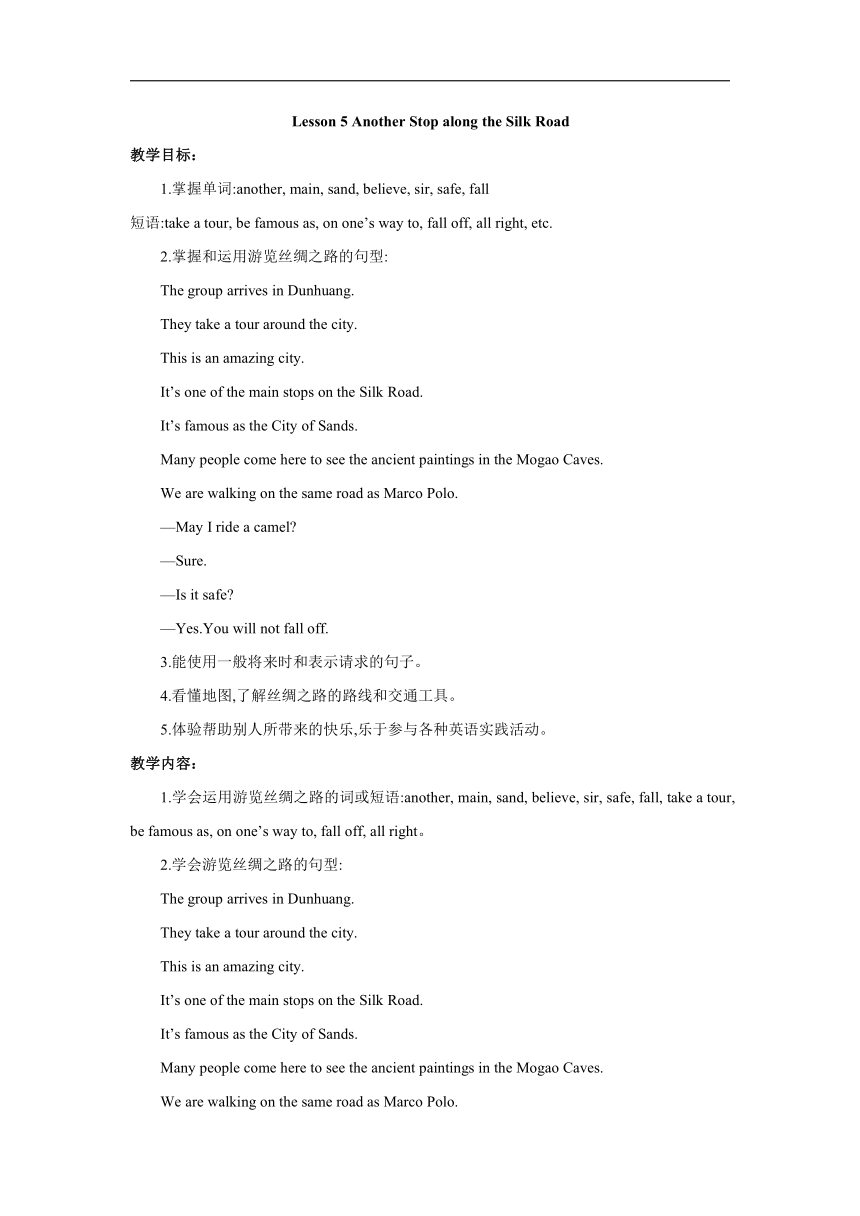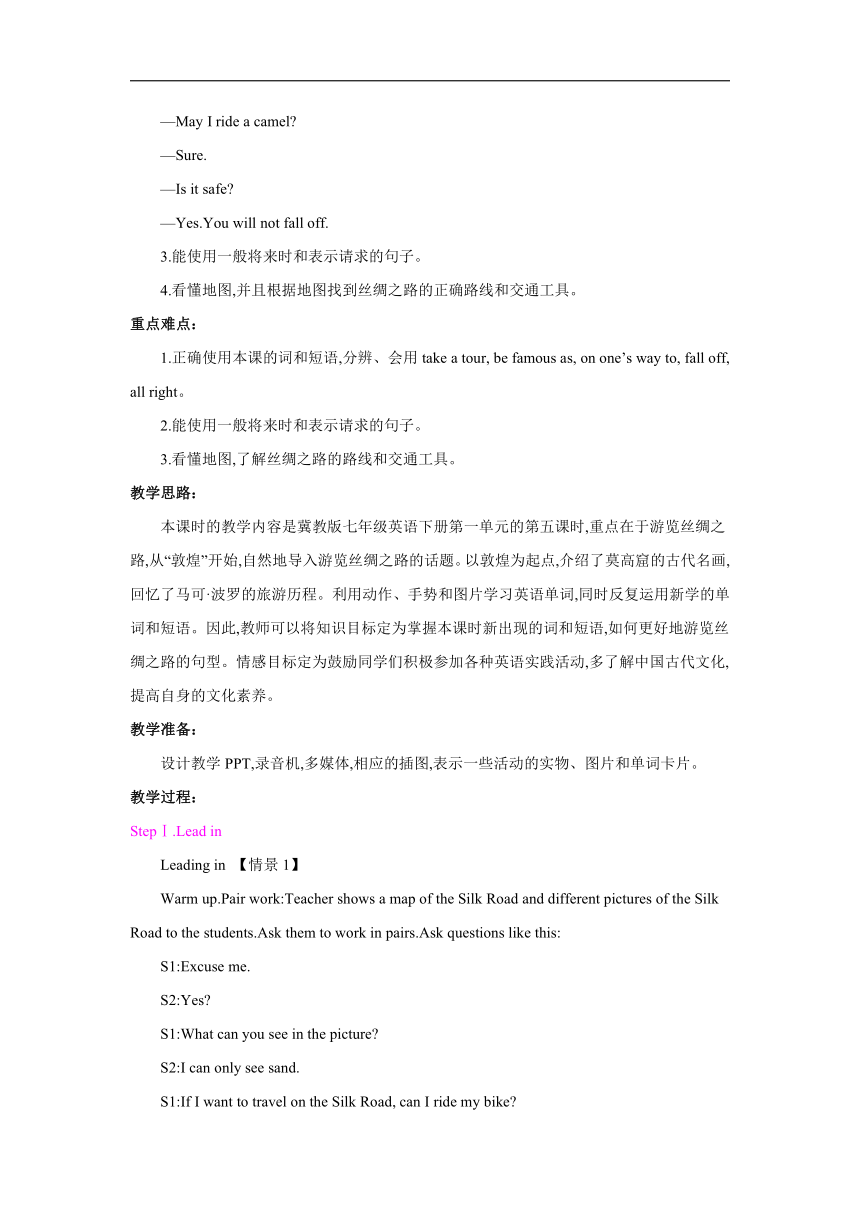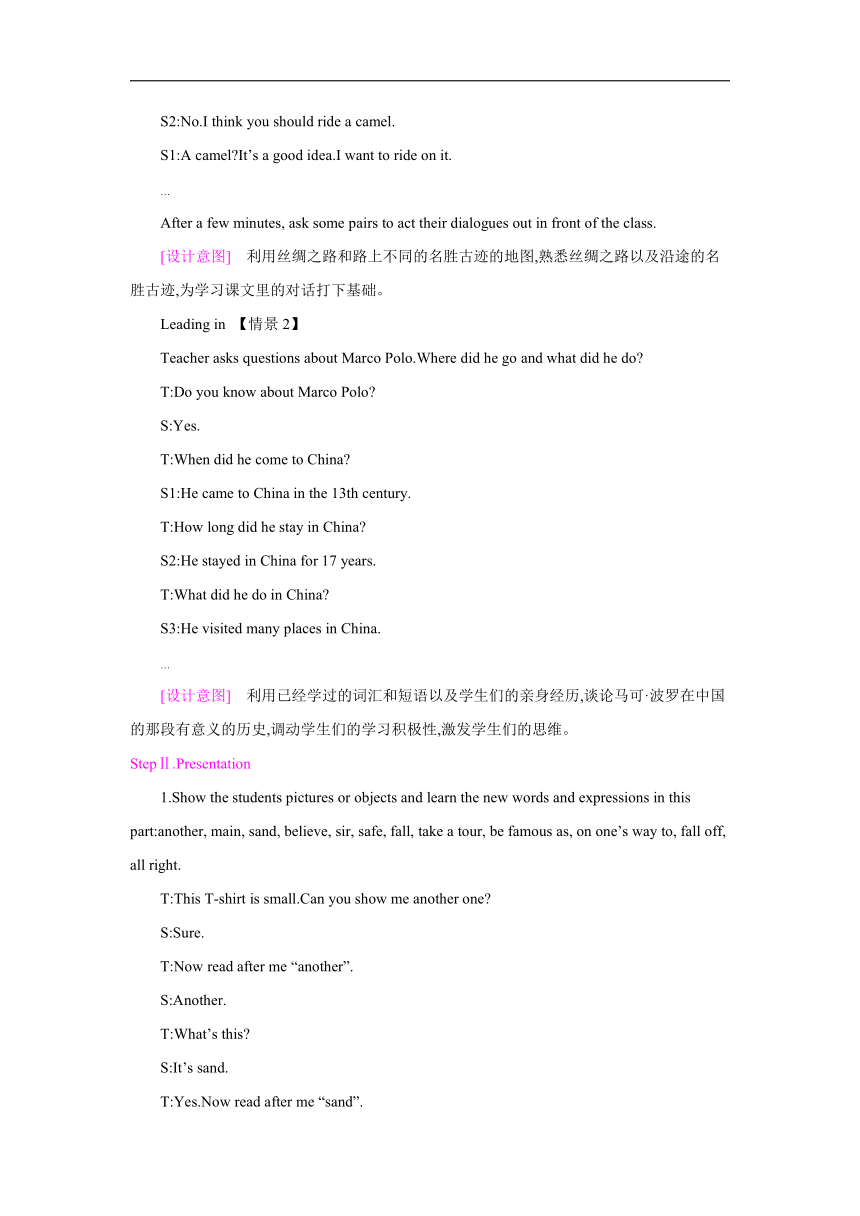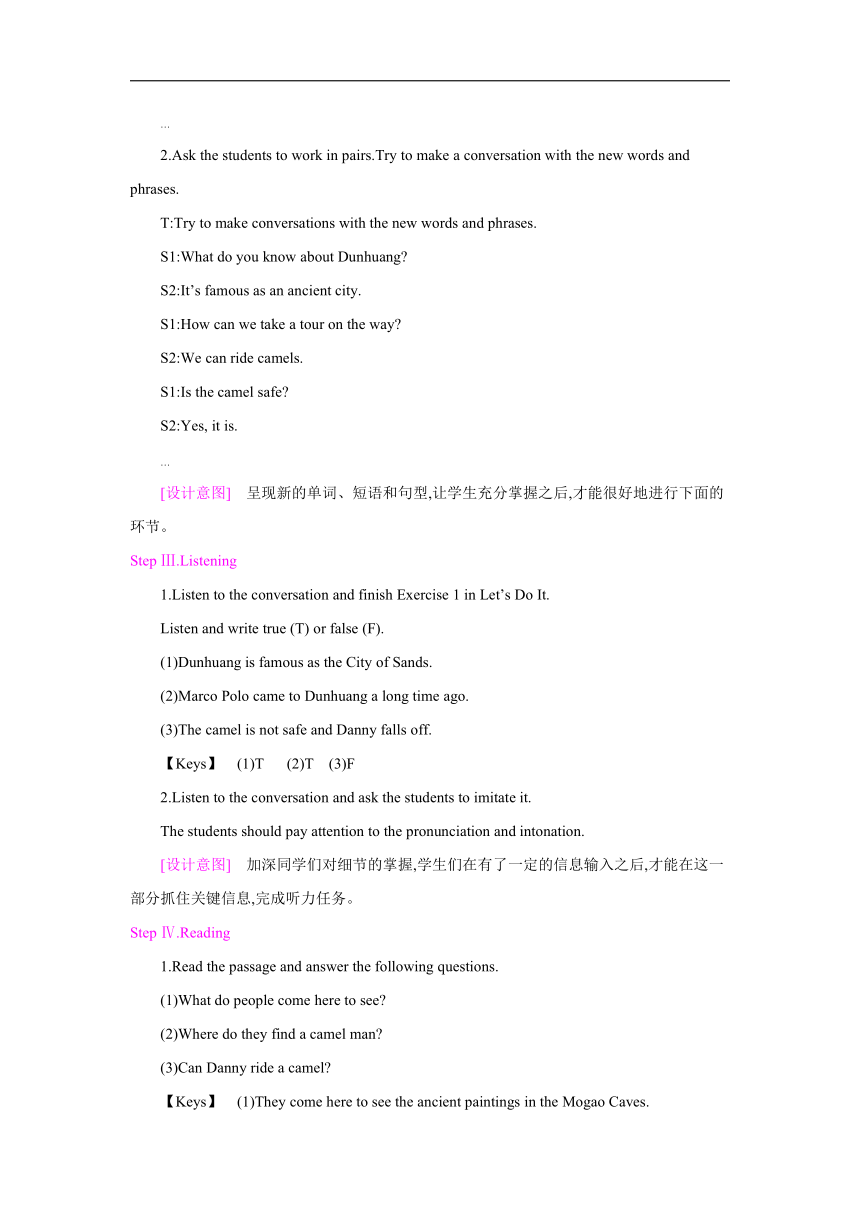Unit 1 A Trip to the Silk Road Lesson 5 Another Stop along the Silk Road 教学设计
文档属性
| 名称 | Unit 1 A Trip to the Silk Road Lesson 5 Another Stop along the Silk Road 教学设计 |  | |
| 格式 | zip | ||
| 文件大小 | 33.5KB | ||
| 资源类型 | 教案 | ||
| 版本资源 | 冀教版 | ||
| 科目 | 英语 | ||
| 更新时间 | 2019-06-26 22:08:00 | ||
图片预览




文档简介
Lesson 5 Another Stop along the Silk Road
教学目标:
1.掌握单词:another, main, sand, believe, sir, safe, fall
短语:take a tour, be famous as, on one’s way to, fall off, all right, etc.
2.掌握和运用游览丝绸之路的句型:
The group arrives in Dunhuang.
They take a tour around the city.
This is an amazing city.
It’s one of the main stops on the Silk Road.
It’s famous as the City of Sands.
Many people come here to see the ancient paintings in the Mogao Caves.
We are walking on the same road as Marco Polo.
—May I ride a camel?
—Sure.
—Is it safe?
—Yes.You will not fall off.
3.能使用一般将来时和表示请求的句子。
4.看懂地图,了解丝绸之路的路线和交通工具。
5.体验帮助别人所带来的快乐,乐于参与各种英语实践活动。
教学内容:
1.学会运用游览丝绸之路的词或短语:another, main, sand, believe, sir, safe, fall, take a tour, be famous as, on one’s way to, fall off, all right。
2.学会游览丝绸之路的句型:
The group arrives in Dunhuang.
They take a tour around the city.
This is an amazing city.
It’s one of the main stops on the Silk Road.
It’s famous as the City of Sands.
Many people come here to see the ancient paintings in the Mogao Caves.
We are walking on the same road as Marco Polo.
—May I ride a camel?
—Sure.
—Is it safe?
—Yes.You will not fall off.
3.能使用一般将来时和表示请求的句子。
4.看懂地图,并且根据地图找到丝绸之路的正确路线和交通工具。
重点难点:
1.正确使用本课的词和短语,分辨、会用take a tour, be famous as, on one’s way to, fall off, all right。
2.能使用一般将来时和表示请求的句子。
3.看懂地图,了解丝绸之路的路线和交通工具。
教学思路:
本课时的教学内容是冀教版七年级英语下册第一单元的第五课时,重点在于游览丝绸之路,从“敦煌”开始,自然地导入游览丝绸之路的话题。以敦煌为起点,介绍了莫高窟的古代名画,回忆了马可·波罗的旅游历程。利用动作、手势和图片学习英语单词,同时反复运用新学的单词和短语。因此,教师可以将知识目标定为掌握本课时新出现的词和短语,如何更好地游览丝绸之路的句型。情感目标定为鼓励同学们积极参加各种英语实践活动,多了解中国古代文化,提高自身的文化素养。
教学准备:
设计教学PPT,录音机,多媒体,相应的插图,表示一些活动的实物、图片和单词卡片。
教学过程:
StepⅠ.Lead in
Leading in 【情景1】
Warm up.Pair work:Teacher shows a map of the Silk Road and different pictures of the Silk Road to the students.Ask them to work in pairs.Ask questions like this:
S1:Excuse me.
S2:Yes?
S1:What can you see in the picture?
S2:I can only see sand.
S1:If I want to travel on the Silk Road, can I ride my bike?
S2:No.I think you should ride a camel.
S1:A camel?It’s a good idea.I want to ride on it.
…
After a few minutes, ask some pairs to act their dialogues out in front of the class.
[设计意图] 利用丝绸之路和路上不同的名胜古迹的地图,熟悉丝绸之路以及沿途的名胜古迹,为学习课文里的对话打下基础。
Leading in 【情景2】
Teacher asks questions about Marco Polo.Where did he go and what did he do?
T:Do you know about Marco Polo?
S:Yes.
T:When did he come to China?
S1:He came to China in the 13th century.
T:How long did he stay in China?
S2:He stayed in China for 17 years.
T:What did he do in China?
S3:He visited many places in China.
…
[设计意图] 利用已经学过的词汇和短语以及学生们的亲身经历,谈论马可·波罗在中国的那段有意义的历史,调动学生们的学习积极性,激发学生们的思维。
StepⅡ.Presentation
1.Show the students pictures or objects and learn the new words and expressions in this part:another, main, sand, believe, sir, safe, fall, take a tour, be famous as, on one’s way to, fall off, all right.
T:This T-shirt is small.Can you show me another one?
S:Sure.
T:Now read after me “another”.
S:Another.
T:What’s this?
S:It’s sand.
T:Yes.Now read after me “sand”.
…
2.Ask the students to work in pairs.Try to make a conversation with the new words and phrases.
T:Try to make conversations with the new words and phrases.
S1:What do you know about Dunhuang?
S2:It’s famous as an ancient city.
S1:How can we take a tour on the way?
S2:We can ride camels.
S1:Is the camel safe?
S2:Yes, it is.
…
[设计意图] 呈现新的单词、短语和句型,让学生充分掌握之后,才能很好地进行下面的环节。
Step Ⅲ.Listening
1.Listen to the conversation and finish Exercise 1 in Let’s Do It.
Listen and write true (T) or false (F).
(1)Dunhuang is famous as the City of Sands.
(2)Marco Polo came to Dunhuang a long time ago.
(3)The camel is not safe and Danny falls off.
【Keys】 (1)T (2)T (3)F
2.Listen to the conversation and ask the students to imitate it.
The students should pay attention to the pronunciation and intonation.
[设计意图] 加深同学们对细节的掌握,学生们在有了一定的信息输入之后,才能在这一部分抓住关键信息,完成听力任务。
Step Ⅳ.Reading
1.Read the passage and answer the following questions.
(1)What do people come here to see?
(2)Where do they find a camel man?
(3)Can Danny ride a camel?
【Keys】 (1)They come here to see the ancient paintings in the Mogao Caves.
(2)They find a camel man on their way to Mingsha Mountain.
(3)Yes, he can.
2.Ask the students to read the dialogue in pairs.
T:Now let’s read the dialogue in pairs.At the same time, pay attention to the pronunciation and intonation.
3.Ask some pairs to read aloud in class.
T:Now let’s see which pair can read best.
4.Read and find the key points.
The following language points should be explained.
☆教材解读☆ 1.They take a tour around the city.
take a tour属于动词短语,意为“游览”。
Shall we take a tour to the Summer Palace?我们去颐和园游览好吗?
2.It’s one of the main stops on the Silk Road.
one of意为“……之一”,后面的名词或代词要用复数形式。
Miss Wang is one of the best teachers in our school.王女士是我们学校最好的老师之一。
3.It’s famous as the City of Sands.
【辨析】 be famous as,be famous for
(1)be famous as是“作为……而著名”的意思,接职业或身份。
Song Zuying is famous as a singer.
宋祖英作为歌唱演员而著名。
(2)be famous for表示“以……而著名”,接著名的原因。
Hangzhou is famous for its tea and silk.
杭州以茶叶和丝绸而著名。
4.Many people come here to see the ancient paintings in the Mogao Caves.
to see属于动词不定式,在句中作目的状语。
We often go to the movie theatre to watch a movie.我们经常去电影院看电影。
5.I can’t believe it!
believe用作实义动词,意为“相信”,用法如下:
(1)believe sb./ sth.相信某人/某事。
I don’t believe what you said.
我不相信你说的话。
(2)believe in sb./sth.信任;信仰。
He believes in his parents.他信任他的父母。
(3)believe 和think一样,当主语为第一人称I 或 we时,把否定词放于believe或think前。
I believe you are right.我相信你是对的。
I don’t believe you are right.我相信你不对。
6.We are walking on the same road as Marco Polo.
the same as意为“同……一样”。
I have the same long hair as my sister.
我和我妹妹有同样的长头发。
My sister’s hair is the same as mine.
我妹妹的头发和我的一样长。
7.They find a camel man on their way to Mingsha Mountain.
on one’s way to意为“在某人去某地的路上”。常用短语:on one’s way home在某人回家的路上;on one’s way to school在某人去上学的路上。
John and Mike are on the way to the park.
约翰和迈克在去公园的路上。
【注意】 one’s要根据主语做具体变化,地点如果为副词home, here, there,要省略to。
He is on his way home.他正在回家的路上。
8.You will not fall off.
fall off用作动词短语,意为“从……跌落/掉落”。
Don’t fall off the bike.
= Don’t fall down from the bike.
不要从自行车上掉下来。
【拓展】 fall down摔倒。
He ran so fast, and he fell down.
他跑得太快,摔倒了。
[设计意图] 根据文章内容填空和读文章,找出问题的答案,设计这样的阅读题有助于学生理解文章细节。
Step Ⅴ.Practice
1.Retell the story.Ask the students to retell the text.Ask a few students to try in class.
2.Work in pairs.Create a new dialogue about the trip on the Silk Road.Ask a few pairs to act them out in front of the class.
S6:Do you like to travel on camels?
S7:Of course.It’s interesting, but I think it’s too slow.
S6:Does it have too much sand on the way to the Silk Road?
S7:Yes, it does.I can see too much sand in the pictures.
S6:Oh, we have to travel on camels.Can we take pictures there?
S7:Sure.There are many places of interest there.We can take many pictures.
…
3.Group work:Teacher shows the places of interest on the Silk Road.Ask the students to say what they are.
After the students practice a few minutes, ask some groups to make a report in front of the class with the help of the pictures.
Group 1:Dunhuang is one of the main stops on the Silk Road.It’s famous as the City of Sands.We can walk on the same road as Marco Polo.We can ride camels on the way to Mingsha Mountain.Many people come here to see the ancient paintings in the Mogao Caves.We hope to find more places of interest there.
…
[设计意图] 利用学生们的实物或图片,创设对话,创设不同的场景,让学生有机会进行多方面的口语练习。
Step Ⅵ.Complete Let’s Do It!
We have finished Exercise 1 in listening part.Ask the students to finish Exercise 2 and Exercise 3 by themselves.Check the answers in class.
[设计意图] Let’s Do It!部分中的Exercise 1重点是听说教学,在课上作为听力任务完成了。让学生们独立完成Exercise 2和Exercise 3,检验课文掌握程度。
Step Ⅶ.Task
Pair work:Let’s Do It! Exercise 4.
Work in pairs.Continue the dialogue in this lesson.What happens after Jenny and Danny get on the camels?
Example:
A:I want to have a picture taken on the camel.Can you help me?
B:Of course.Look here and say, “Cheese!” Great!
A:Thanks.Now I’ll take a picture of you.Smile!
Ask the students to discuss in pairs.Create more dialogues.After a few minutes, ask some pairs to act their dialogues out in front of the class.
[设计意图] 根据课文内容延续对话,表演的学生可以带着地图和图画,这样大家会更透彻地理解学生们编的对话。
Step Ⅷ.Exercises
Fill in the blanks.
1.鲁迅作为一名作家而出名。
Lu Xun is a writer.?
2.你的自行车和我的一样。
Your bicycle is mine.?
3.我和我的同学们在去博物馆的路上。
My friends and I are the museum.?
4.小心!不要从自行车上掉下来。
Look out! Don’t the bicycle.?
5.别担心!你会没事的。
Don’t worry! You will be .?
【Keys】 1.famous as 2.the same as 3.on the way to 4.fall off 5.all right
[设计意图] 以学评教、强化落实。当堂检测主要是由本节内容组成的形成性评价,让学生们巩固本课所学内容。
Step Ⅸ.Homework
1.Remember the words and phrases in this lesson.
2.Read the dialogue after class.
3.Prepare for the next lesson.
[设计意图] 复习、归纳课本内容,课下练习是非常必要的。
Lesson 5 Another Stop along the Silk Road
another, main, sand, believe,sir, safe, fall, take a tour, be famous as,
on one’s way to, fall off, all right
The group arrives in Dunhuang.
They take a tour around the city.
This is an amazing city.
It’s one of the main stops on the Silk Road.
—May I ride a camel?
—Sure.
—Is it safe?
—Yes.You will not fall off.
It’s famous as the City of Sands.
We are walking on the same road as Marco Polo.
【Keys】
2 main, Sands, same, safe
3 1.rides 2.believe 3.another 4.is famous as
5.safe 6.on my way to 7.main
教学目标:
1.掌握单词:another, main, sand, believe, sir, safe, fall
短语:take a tour, be famous as, on one’s way to, fall off, all right, etc.
2.掌握和运用游览丝绸之路的句型:
The group arrives in Dunhuang.
They take a tour around the city.
This is an amazing city.
It’s one of the main stops on the Silk Road.
It’s famous as the City of Sands.
Many people come here to see the ancient paintings in the Mogao Caves.
We are walking on the same road as Marco Polo.
—May I ride a camel?
—Sure.
—Is it safe?
—Yes.You will not fall off.
3.能使用一般将来时和表示请求的句子。
4.看懂地图,了解丝绸之路的路线和交通工具。
5.体验帮助别人所带来的快乐,乐于参与各种英语实践活动。
教学内容:
1.学会运用游览丝绸之路的词或短语:another, main, sand, believe, sir, safe, fall, take a tour, be famous as, on one’s way to, fall off, all right。
2.学会游览丝绸之路的句型:
The group arrives in Dunhuang.
They take a tour around the city.
This is an amazing city.
It’s one of the main stops on the Silk Road.
It’s famous as the City of Sands.
Many people come here to see the ancient paintings in the Mogao Caves.
We are walking on the same road as Marco Polo.
—May I ride a camel?
—Sure.
—Is it safe?
—Yes.You will not fall off.
3.能使用一般将来时和表示请求的句子。
4.看懂地图,并且根据地图找到丝绸之路的正确路线和交通工具。
重点难点:
1.正确使用本课的词和短语,分辨、会用take a tour, be famous as, on one’s way to, fall off, all right。
2.能使用一般将来时和表示请求的句子。
3.看懂地图,了解丝绸之路的路线和交通工具。
教学思路:
本课时的教学内容是冀教版七年级英语下册第一单元的第五课时,重点在于游览丝绸之路,从“敦煌”开始,自然地导入游览丝绸之路的话题。以敦煌为起点,介绍了莫高窟的古代名画,回忆了马可·波罗的旅游历程。利用动作、手势和图片学习英语单词,同时反复运用新学的单词和短语。因此,教师可以将知识目标定为掌握本课时新出现的词和短语,如何更好地游览丝绸之路的句型。情感目标定为鼓励同学们积极参加各种英语实践活动,多了解中国古代文化,提高自身的文化素养。
教学准备:
设计教学PPT,录音机,多媒体,相应的插图,表示一些活动的实物、图片和单词卡片。
教学过程:
StepⅠ.Lead in
Leading in 【情景1】
Warm up.Pair work:Teacher shows a map of the Silk Road and different pictures of the Silk Road to the students.Ask them to work in pairs.Ask questions like this:
S1:Excuse me.
S2:Yes?
S1:What can you see in the picture?
S2:I can only see sand.
S1:If I want to travel on the Silk Road, can I ride my bike?
S2:No.I think you should ride a camel.
S1:A camel?It’s a good idea.I want to ride on it.
…
After a few minutes, ask some pairs to act their dialogues out in front of the class.
[设计意图] 利用丝绸之路和路上不同的名胜古迹的地图,熟悉丝绸之路以及沿途的名胜古迹,为学习课文里的对话打下基础。
Leading in 【情景2】
Teacher asks questions about Marco Polo.Where did he go and what did he do?
T:Do you know about Marco Polo?
S:Yes.
T:When did he come to China?
S1:He came to China in the 13th century.
T:How long did he stay in China?
S2:He stayed in China for 17 years.
T:What did he do in China?
S3:He visited many places in China.
…
[设计意图] 利用已经学过的词汇和短语以及学生们的亲身经历,谈论马可·波罗在中国的那段有意义的历史,调动学生们的学习积极性,激发学生们的思维。
StepⅡ.Presentation
1.Show the students pictures or objects and learn the new words and expressions in this part:another, main, sand, believe, sir, safe, fall, take a tour, be famous as, on one’s way to, fall off, all right.
T:This T-shirt is small.Can you show me another one?
S:Sure.
T:Now read after me “another”.
S:Another.
T:What’s this?
S:It’s sand.
T:Yes.Now read after me “sand”.
…
2.Ask the students to work in pairs.Try to make a conversation with the new words and phrases.
T:Try to make conversations with the new words and phrases.
S1:What do you know about Dunhuang?
S2:It’s famous as an ancient city.
S1:How can we take a tour on the way?
S2:We can ride camels.
S1:Is the camel safe?
S2:Yes, it is.
…
[设计意图] 呈现新的单词、短语和句型,让学生充分掌握之后,才能很好地进行下面的环节。
Step Ⅲ.Listening
1.Listen to the conversation and finish Exercise 1 in Let’s Do It.
Listen and write true (T) or false (F).
(1)Dunhuang is famous as the City of Sands.
(2)Marco Polo came to Dunhuang a long time ago.
(3)The camel is not safe and Danny falls off.
【Keys】 (1)T (2)T (3)F
2.Listen to the conversation and ask the students to imitate it.
The students should pay attention to the pronunciation and intonation.
[设计意图] 加深同学们对细节的掌握,学生们在有了一定的信息输入之后,才能在这一部分抓住关键信息,完成听力任务。
Step Ⅳ.Reading
1.Read the passage and answer the following questions.
(1)What do people come here to see?
(2)Where do they find a camel man?
(3)Can Danny ride a camel?
【Keys】 (1)They come here to see the ancient paintings in the Mogao Caves.
(2)They find a camel man on their way to Mingsha Mountain.
(3)Yes, he can.
2.Ask the students to read the dialogue in pairs.
T:Now let’s read the dialogue in pairs.At the same time, pay attention to the pronunciation and intonation.
3.Ask some pairs to read aloud in class.
T:Now let’s see which pair can read best.
4.Read and find the key points.
The following language points should be explained.
☆教材解读☆ 1.They take a tour around the city.
take a tour属于动词短语,意为“游览”。
Shall we take a tour to the Summer Palace?我们去颐和园游览好吗?
2.It’s one of the main stops on the Silk Road.
one of意为“……之一”,后面的名词或代词要用复数形式。
Miss Wang is one of the best teachers in our school.王女士是我们学校最好的老师之一。
3.It’s famous as the City of Sands.
【辨析】 be famous as,be famous for
(1)be famous as是“作为……而著名”的意思,接职业或身份。
Song Zuying is famous as a singer.
宋祖英作为歌唱演员而著名。
(2)be famous for表示“以……而著名”,接著名的原因。
Hangzhou is famous for its tea and silk.
杭州以茶叶和丝绸而著名。
4.Many people come here to see the ancient paintings in the Mogao Caves.
to see属于动词不定式,在句中作目的状语。
We often go to the movie theatre to watch a movie.我们经常去电影院看电影。
5.I can’t believe it!
believe用作实义动词,意为“相信”,用法如下:
(1)believe sb./ sth.相信某人/某事。
I don’t believe what you said.
我不相信你说的话。
(2)believe in sb./sth.信任;信仰。
He believes in his parents.他信任他的父母。
(3)believe 和think一样,当主语为第一人称I 或 we时,把否定词放于believe或think前。
I believe you are right.我相信你是对的。
I don’t believe you are right.我相信你不对。
6.We are walking on the same road as Marco Polo.
the same as意为“同……一样”。
I have the same long hair as my sister.
我和我妹妹有同样的长头发。
My sister’s hair is the same as mine.
我妹妹的头发和我的一样长。
7.They find a camel man on their way to Mingsha Mountain.
on one’s way to意为“在某人去某地的路上”。常用短语:on one’s way home在某人回家的路上;on one’s way to school在某人去上学的路上。
John and Mike are on the way to the park.
约翰和迈克在去公园的路上。
【注意】 one’s要根据主语做具体变化,地点如果为副词home, here, there,要省略to。
He is on his way home.他正在回家的路上。
8.You will not fall off.
fall off用作动词短语,意为“从……跌落/掉落”。
Don’t fall off the bike.
= Don’t fall down from the bike.
不要从自行车上掉下来。
【拓展】 fall down摔倒。
He ran so fast, and he fell down.
他跑得太快,摔倒了。
[设计意图] 根据文章内容填空和读文章,找出问题的答案,设计这样的阅读题有助于学生理解文章细节。
Step Ⅴ.Practice
1.Retell the story.Ask the students to retell the text.Ask a few students to try in class.
2.Work in pairs.Create a new dialogue about the trip on the Silk Road.Ask a few pairs to act them out in front of the class.
S6:Do you like to travel on camels?
S7:Of course.It’s interesting, but I think it’s too slow.
S6:Does it have too much sand on the way to the Silk Road?
S7:Yes, it does.I can see too much sand in the pictures.
S6:Oh, we have to travel on camels.Can we take pictures there?
S7:Sure.There are many places of interest there.We can take many pictures.
…
3.Group work:Teacher shows the places of interest on the Silk Road.Ask the students to say what they are.
After the students practice a few minutes, ask some groups to make a report in front of the class with the help of the pictures.
Group 1:Dunhuang is one of the main stops on the Silk Road.It’s famous as the City of Sands.We can walk on the same road as Marco Polo.We can ride camels on the way to Mingsha Mountain.Many people come here to see the ancient paintings in the Mogao Caves.We hope to find more places of interest there.
…
[设计意图] 利用学生们的实物或图片,创设对话,创设不同的场景,让学生有机会进行多方面的口语练习。
Step Ⅵ.Complete Let’s Do It!
We have finished Exercise 1 in listening part.Ask the students to finish Exercise 2 and Exercise 3 by themselves.Check the answers in class.
[设计意图] Let’s Do It!部分中的Exercise 1重点是听说教学,在课上作为听力任务完成了。让学生们独立完成Exercise 2和Exercise 3,检验课文掌握程度。
Step Ⅶ.Task
Pair work:Let’s Do It! Exercise 4.
Work in pairs.Continue the dialogue in this lesson.What happens after Jenny and Danny get on the camels?
Example:
A:I want to have a picture taken on the camel.Can you help me?
B:Of course.Look here and say, “Cheese!” Great!
A:Thanks.Now I’ll take a picture of you.Smile!
Ask the students to discuss in pairs.Create more dialogues.After a few minutes, ask some pairs to act their dialogues out in front of the class.
[设计意图] 根据课文内容延续对话,表演的学生可以带着地图和图画,这样大家会更透彻地理解学生们编的对话。
Step Ⅷ.Exercises
Fill in the blanks.
1.鲁迅作为一名作家而出名。
Lu Xun is a writer.?
2.你的自行车和我的一样。
Your bicycle is mine.?
3.我和我的同学们在去博物馆的路上。
My friends and I are the museum.?
4.小心!不要从自行车上掉下来。
Look out! Don’t the bicycle.?
5.别担心!你会没事的。
Don’t worry! You will be .?
【Keys】 1.famous as 2.the same as 3.on the way to 4.fall off 5.all right
[设计意图] 以学评教、强化落实。当堂检测主要是由本节内容组成的形成性评价,让学生们巩固本课所学内容。
Step Ⅸ.Homework
1.Remember the words and phrases in this lesson.
2.Read the dialogue after class.
3.Prepare for the next lesson.
[设计意图] 复习、归纳课本内容,课下练习是非常必要的。
Lesson 5 Another Stop along the Silk Road
another, main, sand, believe,sir, safe, fall, take a tour, be famous as,
on one’s way to, fall off, all right
The group arrives in Dunhuang.
They take a tour around the city.
This is an amazing city.
It’s one of the main stops on the Silk Road.
—May I ride a camel?
—Sure.
—Is it safe?
—Yes.You will not fall off.
It’s famous as the City of Sands.
We are walking on the same road as Marco Polo.
【Keys】
2 main, Sands, same, safe
3 1.rides 2.believe 3.another 4.is famous as
5.safe 6.on my way to 7.main
同课章节目录
- Unit 1 A Trip to the Silk Road
- Lesson 1 A Trip to China
- Lesson 2 Meet You in Beijing
- Lesson 3 A Visit to Xi'an
- Lesson 4 A Visit to Lanzhou
- Lesson 5 Another Stop along the Silk Road
- Lesson 6 Jenny's Diary
- Unit 2 It's Show Time!
- Lesson 7 What's Your Project about?
- Lesson 8 Marco Polo and the Silk Road
- Lesson 9 Danny's School Project
- Lesson 10 Music and Dance
- Lesson 11 Food in China
- Lesson 12 A Blog about the Silk Road
- Unit 3 School Life
- Lesson 13 How Is School Going?
- Lesson 14 Jenny's School Life
- Lesson 15 Making a Difference
- Lesson 16 We Are with You!
- Lesson 17 School Science Fai
- Lesson 18 Teaching in China
- Unit 4 After-School Activities
- Lesson 19 A Dinner Date
- Lesson 20 Join Our Club!
- Lesson 21 What Is Your Club Type?
- Lesson 22 Big Plans for the Weekend
- Lesson 23 A Weekend with Grandma
- Lesson 24 How was Your Weekend?
- Unit 5 I Love Learning English!
- Lesson 25 A Phone Friend
- Lesson 26 Online Phone Calls
- Lesson 27 Amazing English
- Lesson 28 How Do I Learn English?
- Lesson 29 A Door to the World
- Lesson 30 Writing an E-mail in English
- Unit 6 Seasons
- Lesson 31 What Strange Weather!
- Lesson 32 I Can't Wait for Winter!
- Lesson 33 Kim's Favourite Season
- Lesson 34 Steven's Report
- Lesson 35 Surfing in Sydney
- Lesson 36 Spring in China
- Unit 7 Sports and Good Health
- Lesson 37 You Are What You Eat!
- Lesson 38 Stay Healthy!
- Lesson 39 Danny's Report
- Lesson 40 Move Your Body
- Lesson 41 Were People Healthy Then?
- Lesson 42 Know Yourself
- Unit 8 Summer Holiday Is Coming!
- Lesson 43 Have a Good Summer!
- Lesson 44 Volunteering in Summe
- Lesson 45 Baseball Season
- Lesson 46 Get Ready for Summer Holiday!
- Lesson 47 Summer Plans
- Lesson 48 Li Ming's Summer Holiday
